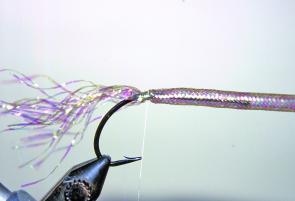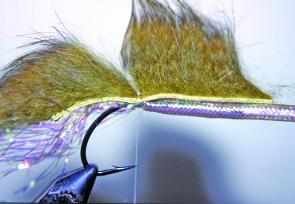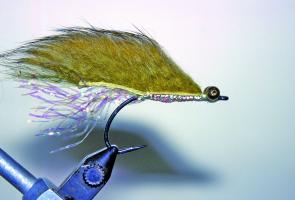There are a lot of great bass flies around these days, many of them born from the ingenuity of Southern Queensland anglers. This month’s pattern is no exception and was shown to me by the late Les James, an extraordinary angler. I had the pleasure of spending many great days with Les doing what we loved best fly fishing.
Les was the kind of bloke who could turn his hand at almost anything and tied many great fly patterns with finesse and care. This month’s pattern was initially given to me by Les for targeting Maroon Dam bass, but it has proven itself time and again on almost every impoundment I have fished. It has caught almost everything that swims in our southern fishery, especially the finicky saratoga.
One of the reasons this fly has worked so well is that it possesses a lot of movement in the water, due mainly to the merits of zonker (rabbit fur strips). This is a great material to use in freshwater flies as it moves and pulses with the minimum of action, which is more important when there is no current.
The profile of the fly is quite slim when wet out of the water, but when put back you can see why fish find it irresistible. The mylar tube used for the body adds a degree of flash to the fly without being too overpowering. The longer strands of mylar at the tail look like air bubbles caused by the frantic paddling of some aquatic creature or drowning terrestrial.
The eyes are bead chain as I do not want the fly to sink quickly, but do want to impart action between strips as the fly slowly sinks headfirst. For Les’s Looney Leech, I used a stinger pattern hook, which is of a thin yet strong construction. It has a short point and small barb to promote easy penetration in the hard mouths of fish such as the saratoga.
Les’s Looney Leech can be fished in a variety of ways that all seem to bring the fly alive in the water. Along the front of weed beds, where water depths exceed 3-4m, fish the fly off a sink-tip line like a Mastery Wet Tip IV. Cast the fly close to the face of the weed bed and then allow it to sink. The bass are often lying in ambush in the weed so the fly is often snavelled as it sinks. Short and sharp strips with a pause between will see the fly darting away like a frightened shrimp or other aquatic morsel. When using an intermediate line try retrieving the fly in a slow mending style, which sees it just swimming along slowly with a minimum of fuss.
Les pioneered another fishing technique for the saratoga at Borumba called the ‘Borumba drift’. This method is used in the middle of the day when the saratoga are lying in the shade of submerged horizontal timber and other shadows. Saratoga are very listless at this time of day and will not chase down a fly with any aggression. Les would cast out the Looney Leech on a floating line with a 3-4m leader and just allow it to slowly sink through the shaded area. Watch the fly line carefully as any change in descent rate or slight sideways movement would indicate that a saratoga had mistaken the fly for a drowning insect and had casually engulfed it. A quick strike would usually see an acrobatic Saratoga burst from the water.
(1). Secure the hook in the vice and attach thread at the end of the hook shank, roughly opposite the point of the hook.
(2). Take a length of mylar tube, which is roughly twice as long as the hook, and tease it out at one end to about half its length. Put the tubing over the hook shank so that the shank passes through the middle of the tubing. You will need to part the mylar fibres around the thread. Once it is in position as shown, secure it with several wraps of thread.
(3). Next, cut a length of the zonker strip about one and a half times as long as the hook shank. Position it roughly as shown and part the fur so that you can secure the zonker by just tying down the skin and not the hair fibres. Do several wraps of thread and whip finish at this point, but do not trim away the remaining thread. This situation is one that demonstrates the importance of being able to whip finish by hand. Whip finishing tools only allow you to whip finish at the front of the fly, not at the rear of the fly. Apply a little head cement to the thread to enhance the longevity of the fly.
(4). Holding the zonker strip up out of the way, wrap the thread around and along the hook shank, tying down the mylar tubing all along the shank. Attach the bead chain eyes just behind the eye of the hook with a series of figure-of-eight wraps.
(5). Pull the zonker strip taut and cut it at the point that coincides with the back of the bead chain eyes. Cut the skin to a forward facing point to allow easier tying in. Pull the skin forward to rest against the back of the bead chain eyes and then do a series of wraps to secure the zonker skin in this position. Whip finish off at this point and apply a little flexcement. Your Les’s Looney Leech is ready for service.
Facts
MATERIALS
HOOK: Gamakatsu B10S size 1
THREAD: Mono Fine
EYE: Bead chain gold large
BODY: Mylar tubing olive medium
BACK: Zonker strip olive variant
Finish: Flexcement









